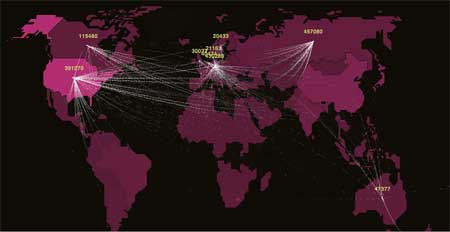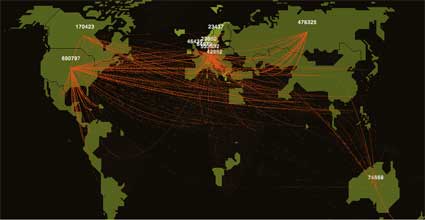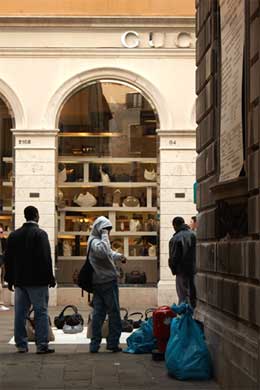Tuborg: Turtles
Posted in: UncategorizedFootstock: Knives
Posted in: Uncategorized2008 National Figure Eight Endurance Barefoot Championships
Advertising Agency: BVK, Milwaukee, USA
Creative Director: Gary Mueller
Art Director: Giho Lee
Copywriter: Ross Lowinske
Photographer: Jeff Salzer
Published: October 2007
Footstock: Shattered glass
Posted in: Uncategorized2008 National Figure Eight Endurance Barefoot Championships
Advertising Agency: BVK, Milwaukee, USA
Creative Director: Gary Mueller
Art Director: Giho Lee
Copywriter: Ross Lowinske
Photographer: Jeff Salzer
Published: October 2007
Footstock: Razor blades
Posted in: Uncategorized2008 National Figure Eight Endurance Barefoot Championships
Advertising Agency: BVK, Milwaukee, USA
Creative Director: Gary Mueller
Art Director: Giho Lee
Copywriter: Ross Lowinske
Photographer: Jeff Salzer
Published: October 2007
Tinker Hatfield and the birth of Nike Air
Posted in: UncategorizedThis is a great interview about how Tinker Hatfield from Nike came up with the design for exposing the “Air Bubble” which is now an iconic feature of Nike.
var addthis_pub = ‘publicisnz’;
Visualizar workshop: HumanFlows
Posted in: UncategorizedAs announced a few days ago, i’m going to highlight some of projects developed in November during the Visualizar workshop curated by Jose Luis de Vicente and organized by the Medialab Prado in Madrid. Participants had two weeks to develop data visualization projects, with the help of three instructors, in addition to assistants and collaborators.
Here’s a first project: Human Flows, by Miguel Cabanzo (with the collaboration of Nathan Yau, Mónica Sánchez and Iman Moradi), aims to visually and interactively map global migrations in a bid to understand their causes. In its current state, it is a framework with which to develop further visualisations.
Miguel is a graphic designer with a growing interest in interactive installations. He is originally from Bogotá, where he studied visual communication, and worked as art director and freelancer). He’s been living in Venice for 3 years as a masters’ student at IUAV, University of Venice.
 Gross Domestic Product
Gross Domestic Product
Human Flow’s aim is to “visually and interactively mapping global migrations in a bid to understand its causes.” Why do you think that there is a need to map migration in a new way? Isn’t there already online instruments which do just that? Which new elements does HF brings to the issue?
Most of the online instruments tend to concentrate on particular moments on migration, showing a partial view of the problem. This happens because global migrations are strongly connected with the current situation (economical, political, social, etc.) of each sending and receiving country, and that produces one of the usual ideas of the migrant: they migrate because they are poor, or their home counties are insecure. But even if this is partially true, I think that seeing this migrations from an historical point of view can raise interesting questions: Why did migrations to Germany become so strong from mid nineties, even from European citizens? Why is so important for Latin American people to go to the United States? Why are Africans risking their lives crossing the ocean to be here? Why were migrations in the eighties so different from today’s migrations?
I think mapping problems helps to understand where the problems are and underline how hard they are. Even if the prototype has inflows from just 13 “well-being” countries from the world, it is incredible to see how 70% of the global population has moved to those countries for the past 15 years, and continues to do so. Why?

2ngry, your website, mentions that you study at IUAV, in Venezia. I spent 4 years as a `’migrant” in Northern Italy myself and although i’m European i experienced how the issue of migration is still a very problematic one here, even more than in other countries. That might be explained by the fact that migration is a relatively new phenomenon in the country. Is there anything in the very particular situation of Venezia which inspired this project or makes it more relevant?
Yes. Even if my position as a student put me somehow aside of the xenophobia problems, is obvious that migration is more than an issue here. Being a relatively new thing, migration seems to be a problem for a lot of northern Italians, who tend to see foreigners (or better: non-tourists) as a threat for the economy. And with the high percentage of illegals entering the country each day, a lot of right wing politicians are basing their careers on it.

Image from Migropolis, Buba sells fake bags in Venice
So if on the one hand you see people praising SS methods against immigrants, in the other you have companies devoted to using them in order to make money, spending a lot in advertising with immigrants as their target group. Add to the picture that lots of Africans are selling Chinese or Napoletan fake bags on the Venetian streets (and “robbing” precious money to the glass stores selling Chinese glass), and you have a strange, contradictory scenario.
Having this in mind, I get involved the past year in a fantastic project called Migropolis, a book about immigration and its spectacularization in Venice. Working for this publication gave me some knowledge about the issues, and served as a starting point for humanflows.
Now that the project is online and working, do you find that the visualization taught you elements that you didn’t suspect would emerge? How does the final result differ from your own expectations?
If brilliant colors means well being, and the flows are going from dark colors to brilliant ones, you can confirm the idea of the poverty-based migration. Of course there were some surprises. I didn’t expect to see so many people going to Russia or germany, and even if I come from Latin America and I know the situation, it was a surprise to see how much people is going in search for their American dream.
Now, I see the project as a framework for further development. To be really enlighten, the project still needs to show more interesting data and, more importantly, clever connections between the data. For instance, it would be interesting to see how migration is affecting criminality in receiving countries, or how much taxes the immigrants are paying, how much they are contributing to the local economy. Remittances are another important field to visualize.
I am very satisfied with the job done, this is a very good starting point.
Do you have any plan to develop the project further?
Yes, humanflows is part of my MA thesis, so the project will be developed furthermore in its conceptual and graphical part in order to show it as part of an exhibition in the near future.
Thanks Miguel!
Also by Medialab Prado: the Interactivos? workshop.
Weetabix: Milk
Posted in: UncategorizedNature’s breakfast.
Advertising Agency: Dentsu Brussels, Belgium
Creative Directors: Wain Choi, Roger Tavares
Art Director: Eric Jamez
Copywriter: Jan Vandenplas
Photographer: Studio Habousha
Other additional credits: Coline Carnoy
Published: December 2007
Weetabix: Spoon
Posted in: UncategorizedNature’s breakfast.
Advertising Agency: Dentsu Brussels, Belgium
Creative Directors: Wain Choi, Roger Tavares
Art Director: Eric Jamez
Copywriter: Jan Vandenplas
Photographer: Studio Habousha
Other additional credits: Coline Carnoy
Published: December 2007
Weetabix: Strawberry
Posted in: UncategorizedNature’s breakfast.
Advertising Agency: Dentsu Brussels, Belgium
Creative Directors: Wain Choi, Roger Tavares
Art Director: Eric Jamez
Copywriter: Jan Vandenplas
Photographer: Studio Habousha
Other additional credits: Coline Carnoy
Published: December 2007
Out, damn’d spot!
Posted in: Uncategorized
The world’s smallest ad?! Check out this clever use of print. Love it or hate it, it gets noticed just like the those pesky pimples it promises to vanquish. The latest work for Clearasil from Euro RSCG Düsseldorf, Germany uses a “specially created pimple sticker” to instantly turn the covers of popular youth magazines into Clearasil Ads. The back of the sticker drives to clearasil.com, and due to high demand they are producing more of the stickers to be used as giveaways. Yeah, I know I can’t wait to cover my Trapper Keeper in pimple stickers — so cool! Still, it’s a really smart use of media. Just wish they would have given a little more thought to the online experience. Once you get there, it’s just another generic product site. Why not replicate the print experience there? Let people upload photos, pimple-ize them and share them with friends? Seems like a huge missed opportunity — almost as big that pimple. How can you miss it?
Technorati Tags: review, advertising, beyond madison avenue
Time Out drafts in The SPA Way to handle busy year
Posted in: UncategorizedTime Out has appointed The SPA Way to handle its consumer business following a six-way pitch.
Green Party’s mayoral bid secures agency help
Posted in: UncategorizedThe Green Party has called in a PR agency to aid its London mayoral candidate Sian Berry in her bid to achieve a strong showing in this year’s election.
MoD loses chief to BearingPoint
Posted in: UncategorizedThe Ministry of Defence (MoD) has lost its director of news to a management and technology consultancy, after five and a half years of service.
Exposure pays thousands over Kidman scent row
Posted in: UncategorizedConsumer agency Exposure has been forced to pay thousands of pounds for its involvement in a spat between The Daily Telegraph newspaper and actress Nicole Kidman, currently the face of Chanel.
Gyro buys out HSD Communications
Posted in: UncategorizedIntegrated comms agency Gyro International has made its first move into the PR industry with the acquisition of healthcare PR shop HSD Communications.
Black housing group to battle against closure
Posted in: UncategorizedOne of the biggest UK ethnic minority housing providers has brought in PR support as it fights a government bid to merge it into a mainstream housing association.
Lucre to push luxury hotels
Posted in: UncategorizedGlobal luxury hotel brand Preferred Hotel Group has appointed consumer shop Lucre to oversee European PR for four establishments.
Manchester’s MC2 agency takes over Vertigo PR
Posted in: UncategorizedVertigo PR, the Manchester consumer agency launched by former Communique MD Nathalie Bagnall, has been acquired by fellow Manchester agency MC2.
Clear winner for lightbulb campaign
Posted in: UncategorizedA company that makes energy-efficient lightbulbs has hired its first PR agency, as the Government presses ahead with plans to ban incandescent bulbs by 2011.








